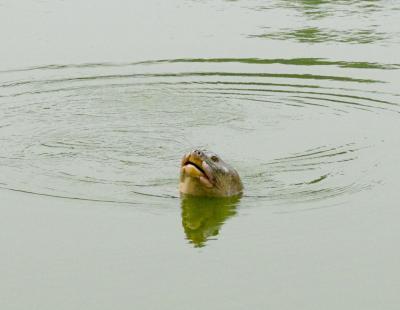A report issued today, co-authored by the Wildlife Conservation Society (WCS) working in conjunction with the Turtle Conservation Coalition, lists the 25 most endangered turtle species from around the world – some of which currently number less than five individuals.
Decimated by illegal hunting for both food and the pet trade along with habitat loss, many turtle species will go extinct in the next decade unless drastic conservation measures are taken, according to the report, which was released at a regional workshop hosted by Wildlife Reserves Singapore and WCS. Seventeen of the 25 species are found in Asia, three are from South America, three from Africa, one from Australia, and one from Central America and Mexico.
The report was authored by the Turtle Conservation Coalition, which is made up by IUCN/SSC Tortoise and Freshwater Turtle Specialist Group, Turtle Conservation Fund, Turtle Survival Alliance, Turtle Conservancy/Behler Chelonian Center, Chelonian Research Foundation, Conservation International, WCS, and San Diego Zoo Global.

One of the last of its kind: a Yangtze giant softshell turtle (Rafetus swinhoei) surfaces in a lake in Vietnam. Once occurring in the river basins of China and Vietnam, the turtle (which can weigh up to 250 pounds) has been decimated as a result of wetland destruction, and water pollution, and poaching. Only four individuals are known to exist.
(Photo Credit: Brian D. Horne/Wildlife Conservation Society)
The list of 25 includes "Lonesome George" – the only remaining Abdington Island giant tortoise. Though there is still scientific disagreement as to whether he is a recognized species or a subspecies of Galápagos tortoise, all agree that he is the last of his kind. Another species on the brink is the Yangtze giant softshell turtle with just four known individuals. Wildlife Conservation Society veterinarians have been working with Chinese officials and other partners to breed the last known male/female pair of these giant turtles, which currently reside at China's Suzhou Zoo.
Illegal hunting for turtles in Asia for food, pets, and traditional medicines is a particular problem, the report says.
"Turtles are being unsustainably hunted throughout Asia," said co-author Brian D. Horne of the Wildlife Conservation Society. "Every tortoise and turtle species in Asia is being impacted in some manner by the international trade in turtles and turtle products. In just one market in Dhaka, Bangladesh we saw close to 100,000 turtles being butchered for consumption during a religious holiday, and we know of at least three other such markets within the city."

The Burmese star tortoise (Geochelone platynota) is characterized by well defined, symmetrical star patterns that radiate across the reptiles carapace or shell. Very little is known about the species, which is threatened by both the pet trade and a demand for meat. The Burmese star tortoise is listed as "Critically Endangered."
(Photo Credit: Brian D. Horne/Wildlife Conservation Society)
Liz Bennett, Vice President of WCS Species Program, said: "Turtles are wonderfully adapted to defend themselves against predators by hiding in their shells, but this defense mechanism doesn't work against organized, large-scale human hunting efforts. The fact is that turtles are being vacuumed up from every nook and cranny in Asia and beyond."
The report says that better enforcement of existing trade laws, habitat protection, and captive breeding are all keys to preventing turtle species from going extinct while bolstering existing populations.

The red-crowned roofed turtle (Batagur kachuga) is one of 25 species listed in a new report issued by the Turtle Conservation Coalition today in Singapore. The species is limited to a few isolated pockets along the Ganges and Brahmaputra River basins in India and Bangladesh and is listed as Critically Endangered on IUCNs Red List.
(Photo Credit: Brian D. Horne/Wildlife Conservation Society.)
Source: Wildlife Conservation Society